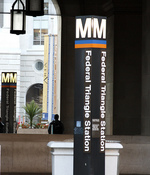Is the federal transit benefit actually bad?
The federal government should discontinue the transit benefit.
Now that I have your attention, hear me out.
Federal employees in the national capital region get direct transportation up to $230 per month, which they can use to pay for transit or vanpool service. To qualify for the benefit, they have to give up parking privileges.
While this policy encourages transit use and discourages single occupancy vehicle commuting, it does that in a way that encourages Metro and other transit providers to increase fares. The policy also ignores the benefits to society and to employees of shorter commutes, like those on bikes or on foot. Eliminating both the transit and parking benefits and providing employees with flexible funds for transportation would remove these problematic incentives.
When WMATA proposes increasing peak hour fares, many commuters are not affected, because they receive a transit subsidy which covers their whole commute. This reduces the pressure on WMATA to hold down fares for everyone, and encourages a fare policy that attempts to raise peak fares even higher to collect more of this subsidy. Meanwhile, the cost difference between peak rail and bus grows, causing poorer residents to take much longer and less efficient bus routes to save money.
Another example of a transit agency reacting to this policy was when Fairfax Connector raised the fare on their Reston to Pentagon express routes. The $7 one-way fare was over the $230 limit, but what kind of support do you think an increase of 133% would have if most of that change were paid by riders?
The policy encourages long-distance commutes, by making a short bus or rail ride effectively the same cost as an extended ride on MARC or VRE. But those shorter rides don’t cost the regional governments the same. Commuter rail infrastructure is expensive, and VRE, for example, is becoming limited in capacity by their railway fleet. Long-distance Metro riders take up space in crowded railcars which could go to people currently being left at stations because the cars are full.
The policy of free, unlimited transit ignores an even cheaper, self propelled mode of transit: walking and cycling. A work colleague lives just two blocks away, and has a five minute commute. Another rides his bike from Alexandria more than one day a week. Yet my commute, from Falls Church, receives more government support, even though theirs is even more energy efficient, environmentally friendly, and healthier.
So how could we change this? First, instead of giving away parking and then giving everyone free transit of they don’t use it, give everyone the same amount of money that they can use on any mode they like. Start charging market rates for parking, but increase pay by something like $150 a month.
Walking or biking would be encouraged, transit riders would be encouraged to choose shorter commutes where they can, and driving would still be discouraged, but allowed. The policy would be more flexible, allowing people to choose to occasionally ride a bike, take transit or even drive, paying only for what they use, rather than having a choice between unlimited parking or essentially unlimited transit. Transit providers would no longer be able to see federal employees as a ready source of revenue without complaints. They would likely have to seek a more balanced fare policy that spreads out the cost among all riders.
Most importantly, charging people for what they use is efficient and fundamentally fair. The federal government and other employers with similar policies should encourage this efficiency and fairness by giving every employee a flat benefit and changing free parking to paid parking.

